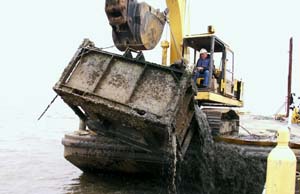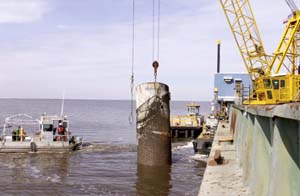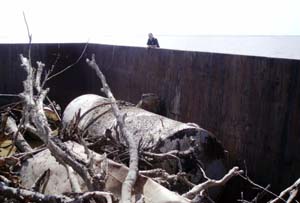| NOAA Magazine || NOAA Home Page |
NOAA TEAM FACILITATES REMOVAL OF DANGEROUS MARINE DEBRIS FROM VITAL LOUISIANA LAKE
 Feb.
20, 2007 � NOAA and the Louisiana
Sea Grant College Program teamed with state and local agencies,
businesses and organizations to help boaters and the environment through
the Calcasieu Lake Marine Debris Marking and Mapping Program. With the
aid from the NOAA Marine Debris
Program and a tremendous volunteer effort, the team identified and
in January facilitated the removal of nearly 100 pieces of marine debris
in Calcasieu Lake, La., a vital shipping channel and significant estuary
for the southwestern Louisiana economy. (Click NOAA image for
larger view of marine debris removed from Calcasieu Lake, La., in January
2007. Please credit “NOAA.”)
Feb.
20, 2007 � NOAA and the Louisiana
Sea Grant College Program teamed with state and local agencies,
businesses and organizations to help boaters and the environment through
the Calcasieu Lake Marine Debris Marking and Mapping Program. With the
aid from the NOAA Marine Debris
Program and a tremendous volunteer effort, the team identified and
in January facilitated the removal of nearly 100 pieces of marine debris
in Calcasieu Lake, La., a vital shipping channel and significant estuary
for the southwestern Louisiana economy. (Click NOAA image for
larger view of marine debris removed from Calcasieu Lake, La., in January
2007. Please credit “NOAA.”)
Heavily damaged by Hurricane Rita in September 2005, Calcasieu Lake became a settling point for debris from nearby industries, homes and wooded areas, pushed northward by hurricane-force winds and an unrelenting storm surge. Calcasieu Lake, a 67 square mile brackish estuary, is shared by commercial and recreational fishermen and boaters and supports finfish, oyster, crab and shrimp harvesting.
 The
program enlisted volunteers with boats to mark and report any debris
they encountered. Louisiana Sea Grant personnel verified the location
of reported debris and logged coordinates into a Global Positioning
System (GPS) database. To compliment identification efforts, the Calcasieu
Parish Sheriff's Office Marine Division volunteered the services of
its side scan sonar-equipped boat that allows operators to view submerged
debris that may otherwise be missed by visual inspections. (Click
NOAA image for larger view of marine debris hoisted from Calcasieu Lake,
La., in January 2007. Please credit “NOAA.”)
The
program enlisted volunteers with boats to mark and report any debris
they encountered. Louisiana Sea Grant personnel verified the location
of reported debris and logged coordinates into a Global Positioning
System (GPS) database. To compliment identification efforts, the Calcasieu
Parish Sheriff's Office Marine Division volunteered the services of
its side scan sonar-equipped boat that allows operators to view submerged
debris that may otherwise be missed by visual inspections. (Click
NOAA image for larger view of marine debris hoisted from Calcasieu Lake,
La., in January 2007. Please credit “NOAA.”)
"Volunteer efforts from sport fishermen, agency partners and the public have been instrumental in identifying and marking marine debris," said Leon Cammen, director, National Sea Grant College Program. "With the recent addition of state-provided funding allowing for debris removal, volunteers can take pride in knowing they contributed to the success of the program."
 The
Louisiana Department of Natural Resources Underwater Obstruction Removal
Program allocated $250,000 to fund extrication of marine debris identified
by the Calcasieu Lake Marine Debris Marking and Mapping Program. In
January, debris removal commenced once the coordinates of approximately
63 pieces of debris were provided to contractor Coral Marine Services,
Inc. During removal and recovery activities, the salvage company identified
additional potentially hazardous debris while performing a standard
scan at known debris sites. This added component proved to be a bonus
contribution to the program’s success. (Click NOAA image
for larger view of marine debris collected from Calcasieu Lake, La.,
in January 2007. Please credit “NOAA.”)
The
Louisiana Department of Natural Resources Underwater Obstruction Removal
Program allocated $250,000 to fund extrication of marine debris identified
by the Calcasieu Lake Marine Debris Marking and Mapping Program. In
January, debris removal commenced once the coordinates of approximately
63 pieces of debris were provided to contractor Coral Marine Services,
Inc. During removal and recovery activities, the salvage company identified
additional potentially hazardous debris while performing a standard
scan at known debris sites. This added component proved to be a bonus
contribution to the program’s success. (Click NOAA image
for larger view of marine debris collected from Calcasieu Lake, La.,
in January 2007. Please credit “NOAA.”)
"We are very pleased with the abundance of help we have received from the public and those who rely on the lake for their livelihood," said Charles Wilson, director, Louisiana Sea Grant College Program.
The National Sea Grant College Program is an organization headquartered in NOAA encompassing 30 university-based programs located in coastal and Great Lakes states and Puerto Rico. Sea Grant engages the capabilities of the finest research universities in addressing coastal and Great Lakes resource management issues consistent with NOAA's mission. The program is a partnership among federal governments, universities, state and local governments, and public participation. This effort saw the collaboration of National and Louisiana Sea Grant with the NOAA Office of Coast Survey and NOAA Office of Response and Restoration to participate in the success of this project and to serve this coastal community and ecosystem.
NOAA, an agency of the U.S. Commerce Department, is celebrating 200 years of science and service to the nation. From the establishment of the Survey of the Coast in 1807 by Thomas Jefferson to the formation of the Weather Bureau and the Commission of Fish and Fisheries in the 1870s, much of America's scientific heritage is rooted in NOAA. NOAA is dedicated to enhancing economic security and national safety through the prediction and research of weather and climate-related events and information service delivery for transportation, and by providing environmental stewardship of the nation's coastal and marine resources. Through the emerging Global Earth Observation System of Systems (GEOSS), NOAA is working with its federal partners, more than 60 countries and the European Commission to develop a global monitoring network that is as integrated as the planet it observes, predicts and protects.
Relevant Web Sites
NOAA Marine Debris Program
NOAA Office of Response and Restoration
Media
Contact:
Daniel Parry, NOAA
Research, (301) 734-1092